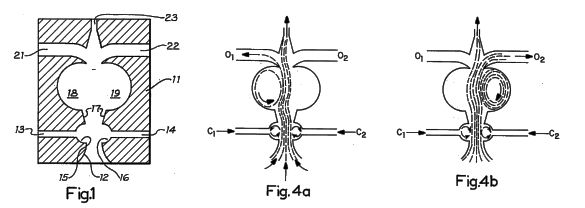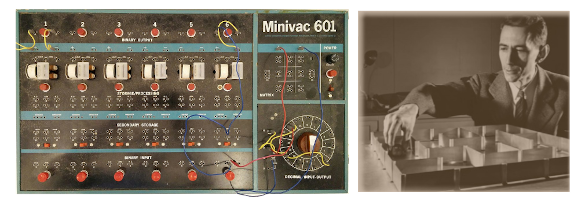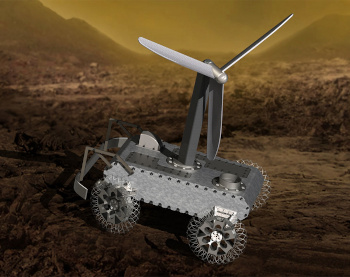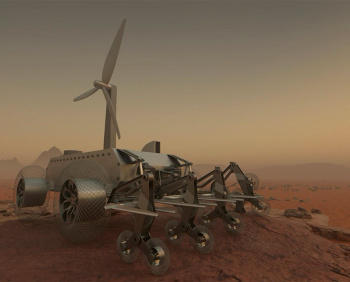Venus Rover
January 17, 2022
Early in my
career, I enjoyed having
lunch with my older
scientist and
engineer co-workers. They always
regaled the lunch group with
arcane knowledge from their careers that's not found in
textbooks. In one case, an
electrical engineer who spent his entire career designing
vacuum tube circuitry told us about how one
radio receiver was designed in a way to reduce its vacuum tube count by one. Since
radio frequencies are much higher than
audio frequencies, a single
triode amplifier with proper
filtering was used to amplify both types of
signals without their interacting with each other.
I was also introduced to the concept of
fluidic amplification by an
aerospace engineer who actually worked with fluidic amplifiers. Although I had once used the strange
electrical amplifier called a
saturable-core reactor, I had never heard of an amplifier that didn't involve
electrons. Aside from amplification,
digital logic can be done by
fluidics, so it's possible to build simple
computers without
electronics. One disadvantage of fluidic circuitry is that it operates at
low speed. However, it has the advantages of being
radiation resistant and working at higher
temperatures than electronics; and,
nanotechnology allows designs with high
complexity.

Fluidic amplifier design from figs. 1 and 4 of US Patent no. 4,000,757, "High gain fluid amplifier," of Peter A. Freeman, April 1, 1977.[1] The fluid (air, water, or an hydraulic fluid) enters at the bottom, and the control ports C1 or C2 can deflect the stream to exit at output ports O1 or O2. The control streams can be much weaker than the deflected stream, so the device has gain. The operating principle is the Coandă effect, which is the tendency of a fluid jet to stay attached to a convex surface and entrain fluid from the surroundings. (Via Google Patents. Click for larger image.)
The short
history of electronic and fluidic
computers pales in comparison with the reign of
mechanical computers. An early example is the
Antikythera mechanism (c. 150 BC), an
ancient Greek orrery, a mechanical
analog computer discovered in an ancient
shipwreck. In more
modern times,
Blaise Pascal (1623-1662) designed his
Pascaline calculator that had the capability to
add and
subtract two
numbers, and to perform
multiplication and
division through repeated addition or subtraction.
A short time later
Leibniz (1646-1716) invented his similar
stepped reckoner in 1672. Leibniz was apparently inspired by a
pedometer, and he
studied Pascal's machine from Pascal's
Pensées. Instead of the
gears of Pascal's machine, this device used a
stepped cylinder. Quite a while later, in the
1820s,
Charles Babbage (1791-1871) created his
difference engine, a mechanical calculator designed to compute
polynomial functions. The
father of
information theory,
Claude Shannon (1916-2001), was inspired to create the 1961
Minivac 601 Digital Computer Kit, an
electromechanical digital computer system intended as an
educational toy (see figure).

The Minivac 601 Digital Computer Kit and its creator, Claude Shannon (1916-2001). Shannon is shown demonstrating a maze-solving mouse, called Theseus. The necessary computation and memory operations for Theseus were done using electromechanical relays. (Left, the Minivac 601, via Wikimedia Commons. Right, still image from a YouTube video by BinarycoreMedia, April 30, 2013, modified for artistic effect.)
We're now accustomed to having extremely functional
scientific rovers, and even a
helicopter, on
Mars.
environmental conditions on Mars are not that extreme, so
ruggedized versions of
terrestrial motors and
electronics are all that are needed to enable their functionality. Having a rover on
Venus is another thing altogether. While Martian temperature is in the range around 210
K (-63
°C), and its surface
pressure is about 0.636
kPa (0.00628
atm), Venus is a
torrid 737 K (464 °C) with an oppressive surface pressure of 9.3
MPa (92 atm). Alternatives to electronics are one way to facilitate a Venus rover that's resistant to such temperature.

An illustration of a concept for a possible wind powered "Automaton Rover for Extreme Environments" on Venus.
The surface winds of Venus are just a few miles per hour, but the density of the atmosphere of Venus gives these winds a high momentum; so, they would drive a wind turbine.
(NASA/JPL-Caltech image. Click for larger image.)
In early 2020,
NASA announced a
contest called
Exploring Hell: Avoiding Obstacles on a Clockwork Rover for design
ideas for an
obstacle avoidance sensor for a Venus rover, with a first-place prize of $15,000, a second-place prize of $10,000, and a third place prize of $5,000.[2-4] The contest was for a non-electronic sensor for a
NASA-JPL concept rover called an Automaton Rover for Extreme Environments (AREE), the
principal investigator of which is
Jonathan Sauder, a senior
mechatronics engineer.[2] The AREE is powered by wind, and it's intended to collect
data at the Venusian surface over a period of
months.[2] Submissions were accepted through May 29, 2020, and winners have been recently announced.[2-3] It's been more than half a
century since the first Venus landing by the
Soviet Venera 7 mission on December 15, 1970.[3] I wrote about the Soviet Venera program is an
earlier article (Veiled Venus, October 8, 2014)
The idea for a mechatronic
steampunk rover built from
high-temperature steel and
titanium, collecting
power from wind and storing it in a
torsion spring, came to Sauder several years ago during a
work break with JPL
colleagues.[3] His
prototype, now at one quarter scale, wouldn't be part of a Venus mission for at least a decade.[3] A wind turbine power source was chosen, since other options are not feasible.[3]
Venusian clouds make
solar power impractical, and a
radioisotope thermoelectric generator can't eliminate heat to the torrid Venusian environment.[3] The wind turbine would store power in a spring and directly drive the rover
wheels.[3-4] This would allow the rover to travel 300
meters per day in three 100 meter bursts.[4]
Initially, the Venus rover was imagined as being totally non-electronic. Various approaches were considered for data recovery, including
engraving data onto
metal disks that would be launched into
space by
hydrogen-filled
balloons, and using
radar retroreflectors.[4] These methods were rejected in favor of conventional
radio, but typical radio electronics will only tolerate temperatures up to 125 °C.[4] While
vacuum tubes will operate at high temperature, it's difficult to maintain a
vacuum against Venusian pressures.[4] Fortunately, the
NASA's Glenn Research Center has been developing
silicon carbide electronics that are operable at high temperature and capable of
transmitting megabits of data daily.[4] One area that still needs development is a high temperature
camera.[3]
As for the
Exploring Hell: Avoiding Obstacles on a Clockwork Rover, 572 entries were submitted from 82
countries.[5] The first place prize was awarded to Youssef Ghali from
Cairo, Egypt, for his "Venus Feelers" concept (see figure).[5,7]

A rendering of the first-place winning concept for the "Exploring Hell: Avoiding Obstacles on a Clockwork Rover" contest - "Venus Feelers" by Youssef Ghali from Cairo, Egypt.[5]
(NASA/HeroX/Youssef Ghali image. Click for larger image.)
![]()
References:
- Peter A. Freeman, "High gain fluid amplifier," US Patent No. 4,000,757. April 1, 1977.
- Matthew Segal and Clare A. Skelly, "NASA Wants Your Help Designing a Venus Rover Concept," NASA Jet Propulsion Laboratory Press Release 2020-038, February 21, 2020.
- Adam Mann, "The Steampunk Rover Concept That Could Help Explore Venus," Wired. December 15, 2020.
- Rob Banino, "Venus rover: a new mission to land on the hellish planet," BBC Sky At Night Magazine, July 9, 2020.
- Ian J. O'Neill and Clare Skelly, "NASA's Venus Rover Challenge Winners Announced," NASA Jet Propulsion Laboratory Press Release 2020-123, July 6, 2020.
- Automaton Rover Prototype Test at Room Temperature, YouTube Video by JPLraw, September 14, 2020.
- Venus Feelers, Obstacle Avoidance Sensor, YouTube Video by Youssef Ghali, July 13, 2020.
Linked Keywords: Career; lunch; scientist; engineer; regale; arcana; arcane knowledge; textbook; electrical engineering; electrical engineer; vacuum tube; electronic circuit; circuitry; receiver (radio); radio frequency; audio frequency; triode; amplifier; filter (signal processing); filtering; signal (electrical engineering); fluidics; fluidic amplification; aerospace engineering; aerospace engineer; electricity; electrical; saturable reactor; saturable-core reactor; electron; digital electronics; digital logic; computer; electronics; clock rate; low speed; radiation hardening; radiation resistant; temperature; nanotechnology; complexity; US Patent no. 4,000,757; fluid; atmosphere of Earth; air; water; hydraulic; control system; input/output; port; deflection (engineering); deflect; fluid dynamics; stream; gain; physical law; principle; Coandă effect; jet (fluid); fluid jet; convex surface; entrainment (hydrodynamics); entrain; Google Patents; history; mechanical computer; Antikythera mechanism (c. 150 BC); Ancient Greece; ancient Greek; orrery; analog computer; shipwreck; modern history; modern times; Blaise Pascal (1623-1662); design; designed; Pascal's calculator; Pascaline; calculator; addition; add; subtraction; subtract; number; multiplication; division (mathematics); Gottfried Wilhelm Leibniz (1646-1716); invention; invent; stepped reckoner; pedometer; research; study; Pensées; gear; step; stepped; cylinder (geometry); 1820s; Charles Babbage (1791-1871); difference engine; polynomial function; father (honorific); information theory; Claude Shannon (1916-2001); Minivac 601 Digital Computer Kit; electromechanics; electromechanical; digital; educational toy; scientific demonstration; maze; mouse; computation; computer memory; relay; Wikimedia Commons; YouTube video; BinarycoreMedia; art; artistic; Mars rover; scientific rover; Ingenuity (helicopter); helicopter; Mars; environment; environmental condition; resilience; ruggedize; Earth; terrestrial; electric motor; Venus; kelvin; Celsius; °C; pressure; pascal (unit); kPa; atmosphere (unit); atm; heat; torrid; MPa; wind-powered Venus rover; illustration; concept; wind power; wind powered; wind; miles per hour; density; atmosphere of Venus; momentum; NASA/JPL-Caltech; NASA; competition; contest; idea; obstacle avoidance; sensor; Jet Propulsion Laboratory; NASA-JPL; principal investigator; Jonathan Sauder; mechatronics; data; month; century; Soviet Union; Venera 7 mission; steampunk; alloy steel; high-temperature steel; titanium; power (physics); torsion spring; break (work); work break; colleague; prototype; Venusian clouds; solar power; radioisotope thermoelectric generator; wheel; meter; engraving; metal; disk (mathematics); outer space; hydrogen; balloon; radar; retroreflector; radio; vacuum; NASA's Glenn Research Center; silicon carbide; transmitter; transmit; megabit; digital camera; country; countries; Cairo, Egypt; Venus Feelers; Youssef Ghali.